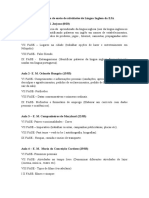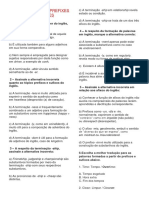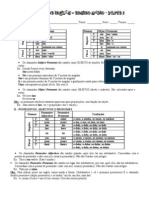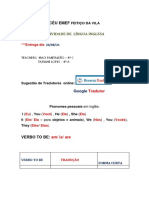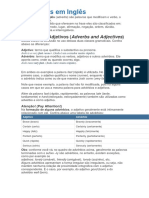There To Be
There To Be
Enviado por
Jéssica Freitas GoulartDireitos autorais:
Formatos disponíveis
There To Be
There To Be
Enviado por
Jéssica Freitas GoulartTítulo original
Direitos autorais
Formatos disponíveis
Compartilhar este documento
Compartilhar ou incorporar documento
Você considera este documento útil?
Este conteúdo é inapropriado?
Direitos autorais:
Formatos disponíveis
There To Be
There To Be
Enviado por
Jéssica Freitas GoulartDireitos autorais:
Formatos disponíveis
2020 – JUNTOS CONSTRUÍMOS PROPÓSITO
FORMAÇÃO INTEGRAL DO ALUNO
Referencial em Educação
THERE TO BE
Usamos o "there to be" para indicar a existência de pessoas, situações e objetos. Tem o mesmo significado
que o verbo "haver" (ou "ter" no sentido de existir), em Português. Todavia, em Inglês, não se pode utilizar o
verbo "to have" para indicar existência. O verbo "to have", que significa "ter", indica apenas posse ou uma
obrigação quando for um verbo modal (modal verb).
There to be - Present
THERE IS: há, existe - É usado com substantivos no singular.
THERE ARE: há, existem - É usado com substantivos no plural.
1 - AFFIRMATIVE FORM:
There is a bus on the street.
There is a boy reading a book under a tree.
There are six billion people living on this planet.
2 - NEGATIVE FORM:
Na forma negativa, basta acrescentarmos "not" após o verbo "to be". Observe os exemplos:
There is not a football field near our house.
There is not anyone at the museum.
OBSERVAÇÃO: As formas negativas podem ser contraídas:
There is not = There isn't There are not = There aren't
Observe alguns exemplos na forma contraída:
There isn't water in the jug.
There aren't buttons on my shirt.
There aren't cockroaches in the kitchen.
3 - INTERROGATIVE FORM:
A forma interrogativa do verbo "there to be" se faz colocando o verbo to be na frente de there:
Are there many stars in the sky tonight?
Is there an ophthalmologist in this clinic?
How many students are there in your classroom?
Is there anything on your desk?
Is there a taxi stand near here?
Você também pode gostar
- Apostila Inglês 1Documento115 páginasApostila Inglês 1Roudens CharlesAinda não há avaliações
- Revisão AdvDocumento1 páginaRevisão AdvAline SousaAinda não há avaliações
- Passive VoiceDocumento3 páginasPassive VoiceSebastião LeitãoAinda não há avaliações
- Gabarito Do Roteiro 17 - Língua Inglesa - 8º AnoDocumento3 páginasGabarito Do Roteiro 17 - Língua Inglesa - 8º AnoAnderson Correa100% (1)
- LÍNGUA INGLESA - 7 ANOS - Artemizia RibeiroDocumento4 páginasLÍNGUA INGLESA - 7 ANOS - Artemizia RibeiroCleginaldo CorreiaAinda não há avaliações
- Plano ANUAL Da Área de Conhecimento de Língua Inglesa - 6 Ano 2022Documento3 páginasPlano ANUAL Da Área de Conhecimento de Língua Inglesa - 6 Ano 2022Patrícia AraújoAinda não há avaliações
- Cronograma de Língua Inglesa EJADocumento4 páginasCronograma de Língua Inglesa EJACarla Andrea Mauler SoaresAinda não há avaliações
- Prepositions of PlaceDocumento11 páginasPrepositions of PlacePAULA DE FREITAS100% (1)
- 7º Ano IngDocumento8 páginas7º Ano IngMarilene Mary100% (1)
- Questoes de Ingles No ENEM (4) - Marcia LucasDocumento19 páginasQuestoes de Ingles No ENEM (4) - Marcia LucasDaniela HillesheimAinda não há avaliações
- Exercises of The Prefixes and SuffixesDocumento2 páginasExercises of The Prefixes and Suffixesjheniffer cunha100% (1)
- Latim Clássico - VerbosDocumento9 páginasLatim Clássico - VerbosMicael Ribeiro100% (1)
- Apostilão - EJA 1 Avaliação - Pronomes - Simple PresentDocumento4 páginasApostilão - EJA 1 Avaliação - Pronomes - Simple PresentFernando Souza JrAinda não há avaliações
- Atividade V Etapa Textos 3Documento3 páginasAtividade V Etapa Textos 3Eduardo CardosoAinda não há avaliações
- As Linking Words São ConjunçõesDocumento7 páginasAs Linking Words São ConjunçõesMatheus FreitasAinda não há avaliações
- Recuperação Das Atividades - ING-8° ANODocumento4 páginasRecuperação Das Atividades - ING-8° ANORhyann SantosAinda não há avaliações
- Futuro Ingles 2Documento4 páginasFuturo Ingles 2Luciana SoaresAinda não há avaliações
- Aula 1 InglesDocumento14 páginasAula 1 Ingles526390Ainda não há avaliações
- Passado SimplesDocumento5 páginasPassado SimplesSandra Patrícia Miranda da SilvaAinda não há avaliações
- Present PerfectDocumento8 páginasPresent PerfectEdgard das nevesAinda não há avaliações
- Estudo Dos VerbosDocumento9 páginasEstudo Dos VerbosLeonardo CastroAinda não há avaliações
- RA - 1MSI - Present PerfectDocumento11 páginasRA - 1MSI - Present PerfectVinícius AmaralAinda não há avaliações
- Pronomes Pessoais em Inglês.Documento3 páginasPronomes Pessoais em Inglês.Garu Jonnin100% (1)
- Simple Present or Present Simple - Aula 2Documento5 páginasSimple Present or Present Simple - Aula 2Marcos ShimbikaAinda não há avaliações
- Present PerfectDocumento4 páginasPresent PerfectEduardo FelipeAinda não há avaliações
- 2pp Ingles 9anoDocumento3 páginas2pp Ingles 9anoDanúbia Gisele Santos SilveiraAinda não há avaliações
- Adjetivos Terminados em - Ed e - IngDocumento3 páginasAdjetivos Terminados em - Ed e - IngfsgsgAinda não há avaliações
- Simple Present Com ExercíciosDocumento19 páginasSimple Present Com ExercíciosDenise Roldão100% (1)
- Ingls 9 AnoDocumento128 páginasIngls 9 AnoLidiane100% (1)
- Avaliação 8 Ano InglesDocumento1 páginaAvaliação 8 Ano InglesAlan Junior Cardoso Da CostaAinda não há avaliações
- Volume 2 - DiagramadoDocumento31 páginasVolume 2 - DiagramadoRose Cunha0% (1)
- Imperative FormDocumento2 páginasImperative FormProfessor AntonioAinda não há avaliações
- (Dois) Exercicio AGOSTO 2 Ano Conectores OkDocumento2 páginas(Dois) Exercicio AGOSTO 2 Ano Conectores OkMário André De Oliveira CruzAinda não há avaliações
- Literatura - Tradição Oral - Batata Cozida, Mingau de CaráDocumento80 páginasLiteratura - Tradição Oral - Batata Cozida, Mingau de CaráEnsino Fundamental100% (4)
- Recuperaão Semestral II - Inglês - 3°ano - 2022Documento2 páginasRecuperaão Semestral II - Inglês - 3°ano - 2022GLEICIANE ANDRADEAinda não há avaliações
- 9 Ano - InglesDocumento12 páginas9 Ano - Inglesnanynha77100% (2)
- Inglês para o EnemDocumento39 páginasInglês para o Enemjoseane souzaAinda não há avaliações
- Will e Going To Slide Lucas Haider 2024Documento31 páginasWill e Going To Slide Lucas Haider 2024Lucas Gomes HaiderAinda não há avaliações
- Happiness Quotations and Verb Tense ReviewDocumento7 páginasHappiness Quotations and Verb Tense ReviewMarianna Alcântara BrittoAinda não há avaliações
- Técnicas de LeituraDocumento1 páginaTécnicas de LeituraDeniseAinda não há avaliações
- Inglês Básico Módulo 3Documento31 páginasInglês Básico Módulo 3Raquel Procopio dos SantosAinda não há avaliações
- 6 Ano INGLESDocumento12 páginas6 Ano INGLESGiovanna Sotero LimaAinda não há avaliações
- False Friends ExercisesDocumento2 páginasFalse Friends ExercisesAdelaide Adurens KonoAinda não há avaliações
- Advérbios em InglêsDocumento3 páginasAdvérbios em InglêsThaís Red LoveAinda não há avaliações
- Exercicio p.30 31 TraducaoDocumento4 páginasExercicio p.30 31 TraducaoADRIANA NIVIA GIRAO LIMA100% (1)
- Prova 2 Serie RecuperaçãoDocumento5 páginasProva 2 Serie RecuperaçãoHoraDoTeacherJames100% (1)
- Modal VerbsDocumento3 páginasModal VerbsDenise Roldão100% (1)
- Interpretação de Texto e Gramática IIDocumento2 páginasInterpretação de Texto e Gramática IIFabiola LuzAinda não há avaliações
- Ingles Lista 04 ConvencionalDocumento4 páginasIngles Lista 04 ConvencionaltvdmariattAinda não há avaliações
- Termo 2 2019 CorrDocumento20 páginasTermo 2 2019 Corrpaganinijulia88Ainda não há avaliações
- Apostila Present ContinuousDocumento10 páginasApostila Present ContinuousLucas GarridoAinda não há avaliações
- Orações Subordinadas SubstantivasDocumento12 páginasOrações Subordinadas SubstantivasCarla FurlanAinda não há avaliações
- ActivityDocumento6 páginasActivitystilovendas7261Ainda não há avaliações
- Ingles - 9o Ano - Apv - 03072020Documento6 páginasIngles - 9o Ano - Apv - 03072020breno oliveira100% (1)
- 8º Anos Avaliação Bimestral InglesDocumento2 páginas8º Anos Avaliação Bimestral InglesKimberly Cardoso De SáAinda não há avaliações
- Verbos Regulares e Irregulares - InglêsDocumento2 páginasVerbos Regulares e Irregulares - InglêsRamiro PauloAinda não há avaliações
- Inglês 6ºs Anos PDFDocumento5 páginasInglês 6ºs Anos PDFclaudiaAinda não há avaliações
- Trabalho de Pesquisa - Verbos Modais - Can - Could - May - Might - Must - ShouldDocumento1 páginaTrabalho de Pesquisa - Verbos Modais - Can - Could - May - Might - Must - ShouldAlecx Wanubio MendesAinda não há avaliações






